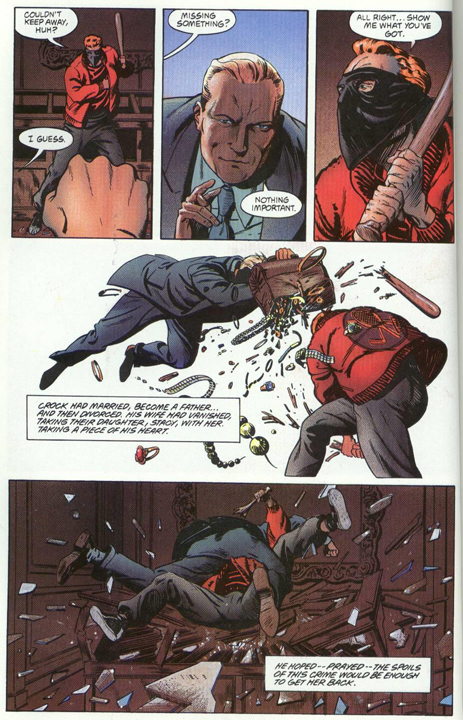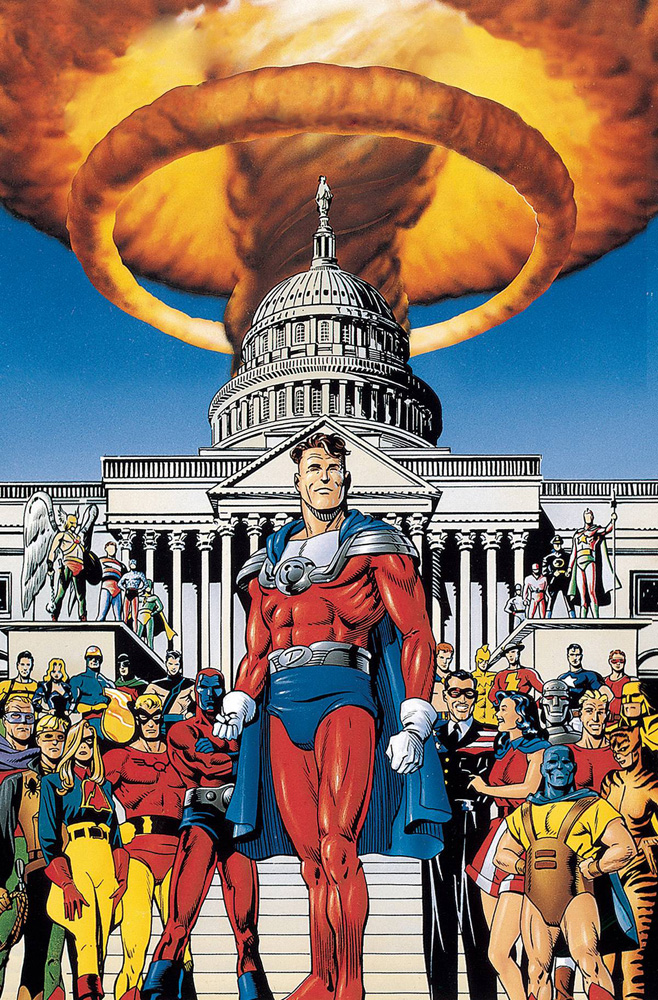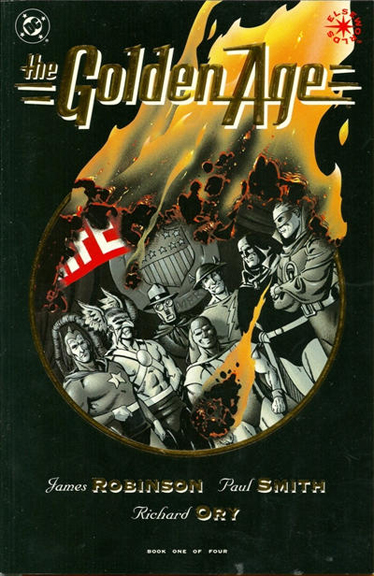THE GOLDEN AGE REVISITED
a KC Column by KC Carlson
In October (but available to pre-order now), DC is reissuing one of the best Justice Society of America storylines in a new deluxe hardcover edition. JSA: The Golden Age was written by James Robinson and illustrated by Paul Smith with Richard Ory colors. It was first published in 1993 as a four-issue Prestige Format series.
JSA: The Golden Age is set in a period after the JSA and other heroes (some of whom served in other teams like the All-Star Squadron and the Freedom Fighters) have mostly all retired or gone underground. The backdrop of this story’s setting are the notorious 1954 hearings held by Senator Joseph McCarthy on a witch hunt for communists, specifically in the US Army but soon extended to run roughshod over the civil rights of anyone who questioned him.
Robinson substitutes the retired superheroes of the 1940s for the US Army, and DC slapped the “Elseworlds” banner on the cover. (To prevent anybody reading it thinking it was real… Excuse me, I meant “real” like in not a real part of the fictional DC Universe. Oh hell, I don’t really know what I mean.) It wasn’t a new idea — Roy Thomas did something similar to explain the disappearance of the original 1940s heroes from then-current continuity in America vs. the Justice Society (1985) — but Robinson told it better, since he made it a story, not just a framing sequence.
Maybe the official DC Elseworlds mantra (which appears somewhere on every Elseworlds project) will help: “In Elseworlds, heroes are taken from their usual settings and put into strange times and places — some that have existed, or might have existed, and others that can’t, couldn’t, or shouldn’t exist.” This book is one of those.
Hmm. Sounds a lot like the beginning of most episodes of Dragnet… except that “can’t, couldn’t, or shouldn’t” bit sounds more like Dr. Seuss (aka Theodor Geisel). How strange that I’m just making these connections now after years of reading them (and editing a few, as well)…
ANYWAY…
JSA: The Golden Age is really good, especially if you’ve studied a bit of that period’s history. It’s an Elseworlds project mostly because not everybody makes it to the end of the story alive. There’s a fair amount of brutality to the story, but apparently not enough to warrant an advisory.
It’s not mentioned in the solicitations (so I hope it hasn’t been removed for this new edition), but the original collection of The Golden Age from 1995 includes a lengthy introduction by Howard Chaykin where he not only eloquently praises the material but also provides for context much comic book history — both in terms of the ongoing art form as well as his own personal history as a comic book reader. Here are just a couple of quotes from him:
“What James Robinson, Paul Smith, and Richard Ory have accomplished with The Golden Age, under the deceptively safe aegis of the Elseworlds logo, is a very witty dissection of post-World War II paranoia, using those selfsame teenage creations, the mystery men of the Golden Age, as the crux of the story.”
And this…
“For those of you familiar with Paul (Smith’s) work on the X-Men, for example, his craft in this book may come as a profound surprise. I have always loved Smitty’s sleek, clean graphic style. . . . But here, Mr. Smith takes a very different approach, working in a style reminiscent of the period he’s illustrating. It’s a risky choice, taking the distinct chance of being parody — but he pulls it off, and grandly. . . . Alex Raymond was a profound influence on the artists of the Golden Age of comic books. It’s only fitting that he should be rediscovered by a sensational talent of this generation like Paul in a sly nod and wink to a master.”
“ARE YOU NOW OR HAVE YOU EVER BEEN…”

Alan Scott (Green Lantern) battles Lawrence Crock (The Sportsmaster) on this interior page from JSA: The Golden Age.
Paul Smith’s art for this project is decidedly different than his usual superhero style (especially from the era in which The Golden Age was originally published). The style takes a little getting used to, but ultimately, it was an excellent choice to help ground this more realistic depiction of a more mature superhero story. The grittiness in Smith’s work perfectly matches both the story and the times it depicts, and ultimately gives the tale its power.
Besides being a great read, The Golden Age is also important historically as one of the key works moving the comics industry towards more mature work. That word has been drastically overused in reference to comics from a certain era, but I don’t mean a story with exaggerated violence or sex or the use of naughty words. I mean that this story incorporates themes and concepts suitable for adult, experienced readers.
Ironically, “Elseworlds” was a more mature way to refer to what were the “Imaginary Stories” of years past. While those original Imaginary Stories were generally juvenile romps about adult issues (marriage, alternate character relationships, and romanticized death), there’s none of that kind of storytelling here. Things happen to the characters in The Golden Age that make you flinch and get angry. And that’s intentional.
If you’ve never read The Golden Age before, this is your chance to read something exceptional. And, if you have read it and misplaced your copy years ago, this is your chance to re-read this new hardcover edition before placing it, in its newly issued upgraded edition, on your bookshelf.
Purchase
JSA: The Golden Age Deluxe Edition HC
__________________________________
KC CARLSON: Apparently, the last DC Elseworlds story was published in 2010. Superman: The Last Family of Krypton was a three-issue miniseries that tells the tale of Superman arriving on Earth — with his parents. It was written by Cary Bates with art by Renato Arlem. I completely missed this series when it was published. Are there any more recent Elseworlds that I’ve missed, being an only occasional DC reader since New 52? I’d love to hear about them.
Wow, does this mean that New 52 killed the Elseworlds concept? Or was the entire New 52 “experiment” actually the biggest (and maybe dumbest) Elseworlds of them all?
Did I just blow your minds? Or do I just have to get my meds adjusted…?



USER COMMENTS
We'd love to hear from you, feel free to add to the discussion!